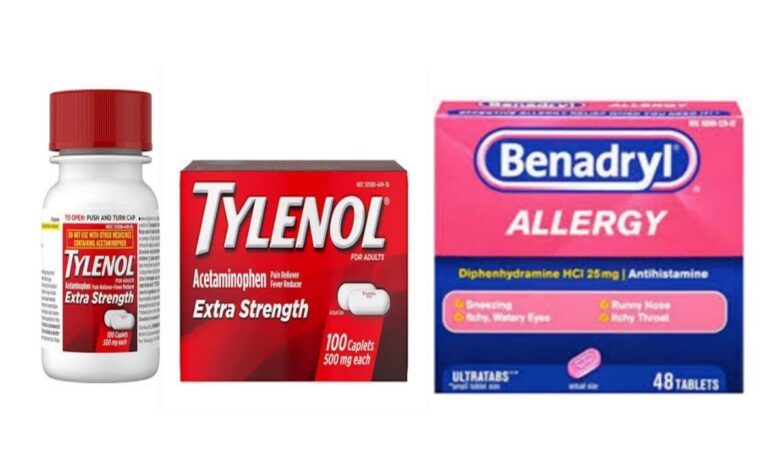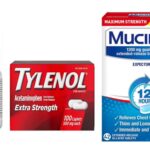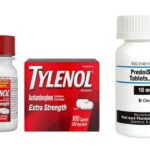Can You Take Tylenol and Benadryl Together?

Mixing any combination of prescription drugs, over-the-counter drugs can be unpredictable and dangerous. Most fatal overdoses involve the use of more than one type of drug (poly-drug use).
Poly-drug use is dangerous because different drugs act on our bodies in different ways. The harmful effects are magnified by using more than one drug type.
What is Tylenol?
Tylenol also known as acetaminophen is a medication that relieves mild-to-moderate pain, headache and fever. You can use acetaminophen to relieve mild or moderate pain. This is usually pain from colds, sore throats, headaches, body or muscle aches, menstrual cramps, arthritis, or toothaches. You can also use it to reduce fever.
It’s not fully known how acetaminophen works. It doesn’t reduce swelling or inflammation. Instead, it’s thought that it blocks the release of certain chemicals in your brain that signal the sensation of pain.
What is Benadryl?
Benadryl is a brand of various antihistamine medications used to stop allergies, whose content varies in different countries, but which includes some or no combination of diphenhydramine, acrivastine, and cetirizine. It is sold by Johnson & Johnson. In the United States and Canada, the active ingredient is diphenhydramine. In the United Kingdom, the active ingredients of Benadryl are the antihistamines acrivastine or cetirizine. Some forms of this product have been discontinued or withdrawn for safety or efficacy reasons
Benadryl is used to relieve allergy symptoms such as sneezing, itching, runny nose, rash, and hives. Some forms of Benadryl are to be taken orally, while some creams and gels are to be applied to the skin. Benadryl is also sold as cough medicine in Australia and New Zealand containing diphenhydramine, as well as the antitussive dextromethorphan or the expectorant guaifenesin.
This medication works by blocking a certain natural substance (histamine) that your body makes during an allergic reaction. Its drying effects on such symptoms as watery eyes and runny nose are caused by blocking another natural substance made by your body (acetylcholine).
Can you take Tylenol and Benadryl together?
Yes, Tylenol and Benadryl are safe to use together and they are sometimes combined and used to treat occasional insomnia associated with minor aches and pains. No interaction exists between Tylenol and Benadryl.
How should I take Tylenol?
Take only one product that contains acetaminophen at a time. Acetaminophen is in many products and you could accidentally take too much if you’re using more than one product at the same time. Acetaminophen can be used by all age groups in recommended doses.
Children (general): The dose of acetaminophen for children is based on body size. Usually, it is calculated as 10 mg to 15 mg per kilogram of body weight, every 4 to 6 hours. No more than 65 mg/kg should be given in a 24-hour period. Children should not take more than 5 doses in 24 hours unless advised by a doctor. For children under 6 months of age, consult a doctor.
Children’s liquid medications should be given using a calibrated dosing device, such as an oral syringe. This ensures that you are giving your child the right amount. Some formulations of liquid acetaminophen contain different concentrations of acetaminophen. Pay careful attention to the concentration on the label and the calculated dose volume.
Adults: The dose of acetaminophen for adults is 325 mg to 650 mg every 4 to 6 hours. Do not take more than 4,000 mg in a 24-hour period. If you are taking the extended-release caplets, the recommended dose for adults and children over 12 years is 1300 mg taken every 8 hours.
Acetaminophen products available without a prescription should not be used for longer than 5 days in a row for pain or 3 days in a row for fever. If you consume 3 or more alcoholic drinks in a day, do not take acetaminophen products, as your risk of liver damage is increased.
Many things can affect the dose of medication that a person needs, such as body weight, other medical conditions, and other medications. If your doctor has recommended a dose different from the ones listed here, do not change the way that you are taking the medication without talking to your doctor. Always take acetaminophen exactly as prescribed by your doctor.
How should Benadryl be used?
Benadryl comes as a tablet, a rapidly disintegrating (dissolving) tablet, a capsule, a liquid-filled capsule, a dissolving strip, powder, and a liquid to take by mouth. When diphenhydramine is used for the relief of allergies, cold, and cough symptoms, it is usually taken every 4 to 6 hours. When diphenhydramine is used to treat motion sickness, it is usually taken 30 minutes before departure and, if needed, before meals and at bedtime.
When Benadryl is used to treat insomnia, it is taken at bedtime (30 minutes before planned sleep). When diphenhydramine is used to treat abnormal movements, it is usually taken three times a day at first and then taken 4 times a day. Follow the directions on the package or on your prescription label carefully, and ask your doctor or pharmacist to explain any part you do not understand. Take diphenhydramine exactly as directed. Do not take more or less of it or take it more often than prescribed by your doctor or directed on the label





